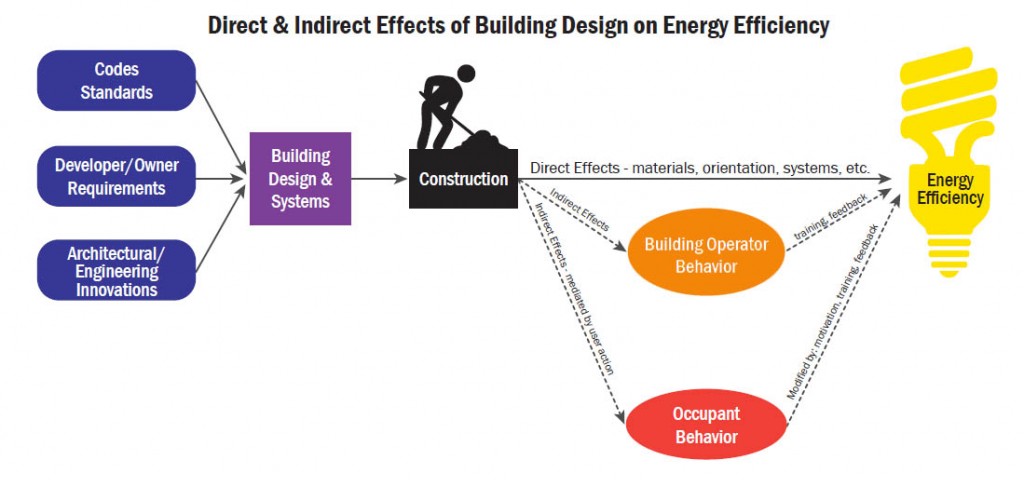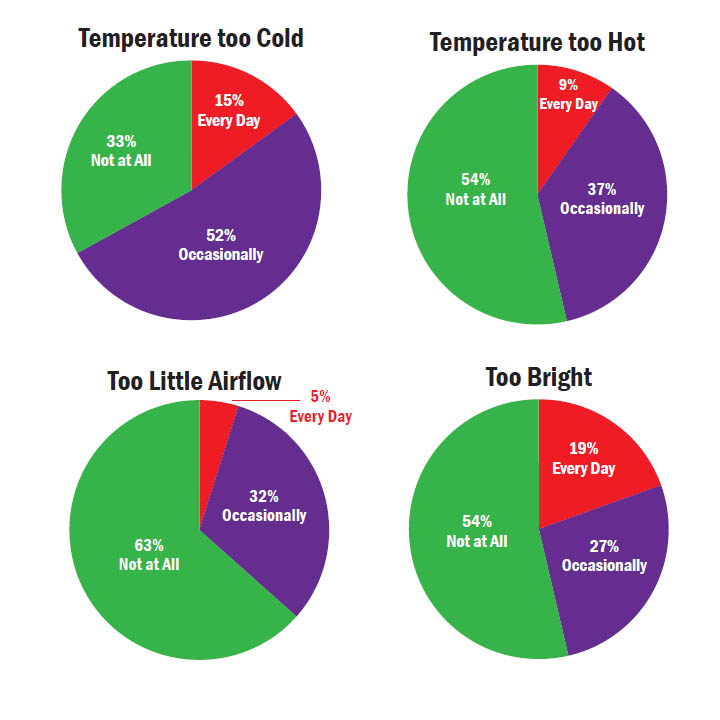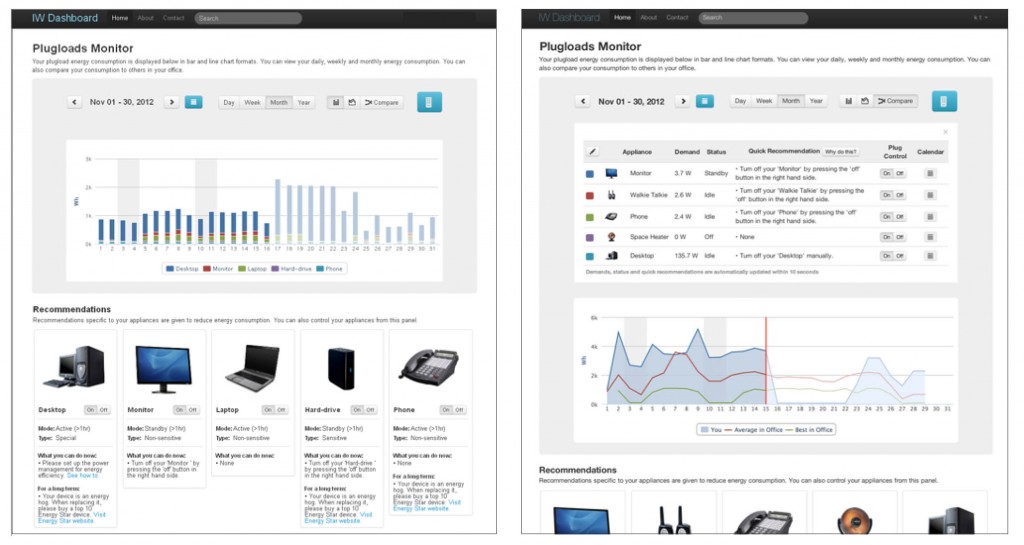Building Users are the Key to Successful Energy Efficient Strategies
Original Research led by Dr. Clinton Andrews, Director of the Center for Green Building at Rutgers University
Introduction
The success of energy efficiency measures depends not only on the design and installation of appropriate technology, but also on occupants, the people who work and live in buildings—a group that is sometimes overlooked in energy efficiency design. A measure that reduces energy but sacrifices occupant comfort would likely fail to achieve its intended energy savings because occupants would act to override their discomfort—for example, pulling down shades and turning on lights to avoid glare from poorly designed daylighting. Recognizing the importance of occupant comfort in the long-term success of energy efficiency measures, CBEI is exploring the difficulties of transitioning energy conservation measures from the virtual modeling world to the real world, as well as the potential ways occupants and building managers can be incentivized to maximize energy efficiency.
CBEI members investigating the relationship between building occupants and energy efficiency have laid out the following two objectives: (1) to understand how energy efficiency projects affect occupant satisfaction, productivity, and health; and (2) to identify behavioral strategies for reducing energy use. CBEI collaborators from Rutgers University, Carnegie Mellon University (CMU), Penn State University (PSU), and the Princeton Plasma Physics Lab (PPPL) have been working to address these questions.
Energy Efficiency and Occupant Satisfaction
Researchers at Rutgers University and Drexel University (a former collaborator on this research) developed independent research reports based in part on interviews with office workers to identify the issues that present the largest obstacles to occupant comfort and to energy efficiency.
The primary purpose of the Rutgers report was to understand what happens when occupants encounter energy conservation measures in the real world. Do occupants notice subtle changes to the thermal comfort and lighting in their work environment intended to reduce energy consumption, and, if so, how do they respond?
Ultimately, the research reinforced the fact that buildings with multiple tenants are complex and the way tenants interact with their surroundings can be influenced by several factors, including workplace objectives, work styles, and personal preferences.
In some instances, tenants’ decisions operate to reinforce the intention of energy efficiency efforts; for example, when employees turn to task lighting, a less energy intensive mode of space lighting, in response to reduced overhead lighting, they conserve energy.
In other cases, the way employees react to energy efficiency measures runs in direct opposition to the intent of the measures. For example, when building managers turn down the heat to conserve electricity, some employees bring in personal space heaters, which are very energy intensive.
This research also highlights the need for coordination between building design and tenant interior fit-out. Lack of coordination on this front presents a fundamental – and all too common – obstacle to achieving energy efficiency in commercial buildings. Researchers point to the fact that the ability to control thermostats and lighting is often fragmented throughout an organization, creating confusion about who has the responsibility to manage energy use. Miscommunication and misinformation can lead to overuse of energy and unsatisfied tenants. This issue, termed “locus of control” by researchers, is similar to the issue of split incentives, but is often more complicated because of the greater number of actors involved. Split incentives traditionally must be negotiated between only two stakeholders, but in a multi-tenanted building, the stakeholders include the occupant, tenant, building operator, and the building owner [1].
Preliminary data from the Drexel study noted that occupant comfort is strongly correlated with the ability to adapt the environment to personal needs and preferences. The study suggested that providing occupants with greater control over their work environments could cut energy use significantly, since 52% of respondents report being too cold in summer and 40% are too hot in winter, pointing to inefficient overuse of HVAC systems [2].
The study also found that approximately 40% of occupants use personal heaters or fans, measures which directly impact building energy use. Researchers found that while energy efficiency was not a primary motivator for office occupants, enthusiasm among workers for energy education programs was high, with most respondents highlighting the need for tracking and feedback on energy efficiency measures over time, a void that CBEI has acknowledged with the creation of tools to influence occupant behavior.
Behavioral Strategies
In addition to assessing the impacts of energy efficiency measures on occupant satisfaction and productivity, EEB Hub projects seek to develop and assess the impact of feedback mechanisms, social networking, and “serious games” on occupant behavior. CBEI has tested this work at the offices of the Princeton Plasma Physics Lab where nearly 40% of all employees have participated in CBEI-driven occupant behavior research.
To provide an interactive way for occupants to track and manage their energy consumption, researchers at PSU developed a serious game that links an employee’s energy use to the health of a virtual flock of chickens. Each office appliance is connected to the Energy Chickens game with a Plugwise device, a monitoring tool that wirelessly tracks the energy data for each appliance. Every ten seconds, data from the appliance is uploaded to the Energy Chickens game, which processes the information and compares it to the employee’s weekly and monthly energy use. Each appliance, such as a fan, a computer, or a coffee machine, is linked to a chicken in the virtual barnyard, which will grow and lay eggs as the individual reduces energy use of that appliance. If energy consumption increases relative to an individual’s baseline, the chicken will become sickly and stop laying eggs.
Following an initial pilot phase at PSU’s Stuckeman School of Architecture and Landscape Architecture, researchers assessed the game with a user evaluation survey. The survey showed that 78 percent of users found the game useful; every respondent indicated that the game helped them to be more energy efficient. Analysis of the corresponding data indicated an initial energy savings of between 9% and 50%. The game was well reviewed by participants at PPPL who, from brief interviews, noted that the game incentivized them to save energy in their work spaces. The final PPPL study results are currently being compiled.
Hub collaborators at CMU have developed an energy dashboard, a tool to increase awareness of the effects of individual energy consumption on office- and building-wide energy use and encourage users to manage their energy use. Similar to the Energy Chickens game, the energy dashboard is an online application that logs consumption data over time, also utilizing Plugwise devices.
The dashboard includes an innovative feature that allows office workers to remotely shut off personal appliances. The potential impact of this technology is significant: an Alliance to Save Energy report estimated that $2.8 billion in energy costs is lost each year as a result of office computers that are not turned off when employees leave the office. Studies using the dashboard application were launched at CMU and PPPL offices in mid-October. Preliminary findings at CMU showed a 60%-70% energy reduction compared to the pre-dashboard baseline, while PPPL results are still being determined.
Researchers at CMU envision expanding the dashboard functionality to include personal HVAC and lighting controls. Placing control directly into the hands of the occupants diverges from the building industry trend of utilizing model predictive controls to automatically adjust building conditions. Model predictive controls interpret occupancy and weather data, among other factors, in order to optimize lighting and HVAC performance.
A mode of control that empowers occupants, especially one that provides energy usage feedback like the Energy Chickens game and the CMU dashboard, has significant potential to increase occupant comfort and occupant satisfaction while simultaneously promoting energy conservation. A positive impact on the quality of life of the building occupants can influence the rate of market uptake for such projects, allowing for greater worker satisfaction, productivity, and energy efficiency in commercial buildings across the region.
“What-if” Simulations
Rutgers helped disseminate this behavioral research by creating a computer simulation showing how occupants interact with building systems. Using data from their field research, the team calibrated an agent-based model of occupant behavior and created an add-on to EnergyPlus, an engineering model of how buildings use energy. This integrated tool can help architects and engineers design energy-efficiency retrofits that are user-friendly and help building operators balance the twin goals of saving energy and keeping occupants comfortable [3].
References:
[1] Rutgers University. (2012). Load Shedding, from http://www.pppl.gov/loadshedding
[2] Building Science and Engineering Group. (2012). Drexel University Year 1: GPIC Policy, Markets, and Behavior Research, from http://bseg.cae.drexel.edu/gpic-year-1-report/
[3] Andrews, C.J., Senick, J.A., Wener, R.W., and M. Sorensen Allacci. (2012) “Investigating Building Performance Through Simulation of Occupant Behavior,” GreenBuild 2012 Proceedings, San Francisco, CA
Further Readings:
Yun, R., Lasternas, B., Aziz, A., Loftness, V., Scupelli, P., Rowe, A., Kothari, R., Marion, F., & Zhao, J. (2011). Toward the Design of a Dashboard to Promote Environmentally Sustainable Behavior among Office Workers.
Yun, R. Scupelli, P., Aziz, A., & Loftness, V. (2011). Sustainability in the Workplace: Nine Intervention Techniques for Behavior Change.




